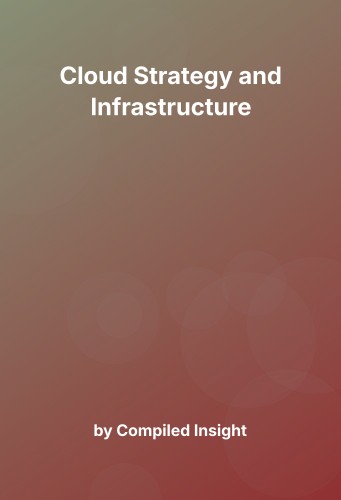Cloud Strategy and Infrastructure Learning Pathway
Introduction
Cloud computing has become a cornerstone of modern digital transformation, offering unprecedented flexibility, scalability, and efficiency for businesses of all sizes. This pathway explores the strategic, architectural, and operational components of cloud infrastructure, with a focus on helping professionals make informed decisions about cloud adoption, platform selection, cost management, and long-term modernization.
1. Defining a Cloud Strategy
A cloud strategy defines how an organization uses cloud technologies to achieve business goals. It serves as a guide for evaluating deployment models (public, private, hybrid), cloud providers, and governance frameworks.
Key Components of a Cloud Strategy
- Business Alignment: Ensure that cloud adoption supports core business objectives such as growth, agility, and innovation.
- Workload Assessment: Categorize workloads based on portability, criticality, and regulatory needs.
- Cloud Model Selection: Choose between IaaS, PaaS, SaaS, and hybrid models based on flexibility, control, and operational maturity.
- Exit Strategy: Plan for portability and migration in case of provider lock-in or strategic shifts.
Common Strategy Patterns
- Cloud First: Mandating cloud adoption for all new services.
- Cloud Smart: Prioritizing cloud based on business case fit.
- Hybrid Cloud: Maintaining critical workloads on-prem while using public cloud for scalability.
- Multi-Cloud: Leveraging multiple vendors to avoid lock-in and gain access to best-of-breed services.
2. Core Infrastructure Concepts
Compute
Cloud compute options range from traditional virtual machines (VMs) to containers, serverless functions, and bare metal. Key considerations include:
- Elasticity: Auto-scaling and on-demand provisioning.
- Virtualisation: Choice of hypervisors (KVM, Hyper-V, Xen) for VMs.
- Containerisation: Kubernetes and Docker for microservices and portability.
Storage
Storage must align to performance, durability, and accessibility needs:
- Block Storage: Persistent disks for VM workloads.
- Object Storage: Scalable and cost-efficient (e.g., Amazon S3, Azure Blob).
- File Storage: Network file shares for legacy or collaborative applications.
Networking
Cloud networking connects compute and storage resources securely and efficiently:
- Virtual Networks: Isolated networking segments per tenant or service.
- Load Balancing: Distributes traffic across resources.
- Edge Connectivity: Content delivery and hybrid integration (e.g., VPNs, ExpressRoute, Direct Connect).
3. Cloud Architecture Principles
Modern cloud infrastructure design embraces the following principles:
3.1 Scalability and Elasticity
Design to handle dynamic workloads through horizontal scaling and stateless architectures.
3.2 Resilience and Availability
Distribute applications across zones and regions. Use redundant resources and automated failover.
3.3 Security by Design
Incorporate identity, access management, encryption, and monitoring from the ground up.
3.4 Automation and Infrastructure as Code (IaC)
Leverage IaC tools like Terraform, AWS CloudFormation, or Pulumi to manage infrastructure declaratively and at scale.
3.5 Observability
Design systems with telemetry, logging, and tracing to monitor health and performance.
4. Cloud Migration
Moving from on-premise systems to cloud environments is a complex process involving assessment, planning, and execution.
4.1 The 6 R’s of Migration
- Rehost (Lift and Shift)
- Refactor (Re-code for cloud)
- Revise (Modify and move)
- Rebuild (Recreate cloud-native)
- Replace (SaaS adoption)
- Retain/Retire (Keep or decommission)
4.2 Phased Migration Approach
- Assessment: Evaluate technical and financial readiness.
- Pilot: Start with non-critical workloads.
- Migration Factory: Build repeatable processes and tooling.
- Optimisation: Refine for cost, performance, and security.
4.3 Tools and Platforms
Popular migration tools include AWS Migration Hub, Azure Migrate, Google Cloud Migrate, and third-party offerings like CloudEndure or Carbonite.
5. Cost Management and Cloud FinOps
Cloud adoption introduces variable pricing models that require financial discipline and transparency.
5.1 Key Principles of FinOps
- Visibility: Track and attribute cloud spend to services, teams, and projects.
- Accountability: Encourage engineering teams to own the cost of resources.
- Optimisation: Rightsize instances, reserve capacity, and eliminate waste.
5.2 Pricing Models
- On-Demand: Pay-as-you-go flexibility.
- Reserved Instances: Lower cost for long-term commitments.
- Spot/Premptible Instances: Deep discounts for interruptible workloads.
5.3 Tools
- Native: AWS Cost Explorer, Azure Cost Management, Google Cloud Billing.
- Third-party: Apptio, Cloudability, Spot.io, Harness.
6. Compliance, Governance, and Security
Cloud introduces new security and compliance risks that must be addressed through a structured governance framework.
6.1 Identity and Access Management (IAM)
Implement least-privilege access, multi-factor authentication, and role-based policies.
6.2 Compliance Frameworks
Align with ISO 27001, SOC 2, GDPR, HIPAA, or industry-specific regulations.
6.3 Security Controls
- Encryption at rest and in transit.
- Secure APIs and secrets management.
- Continuous vulnerability scanning and patching.
6.4 Cloud Governance Models
- Policy as Code (e.g., OPA/Gatekeeper)
- Cloud Guardrails (organizational units, service control policies)
- Audit and Reporting (CloudTrail, Azure Monitor, GCP Operations)
7. Evolving Trends in Cloud Infrastructure
7.1 Edge Computing
Bringing compute closer to users/devices to reduce latency (e.g., AWS Wavelength, Azure Stack Edge).
7.2 Hybrid and Multi-Cloud
Vendors offer seamless integration between on-prem and cloud (e.g., Anthos, Azure Arc, AWS Outposts).
7.3 Serverless and Event-Driven Architectures
Allows teams to focus on code and events, abstracting infrastructure.
7.4 AI/ML Infrastructure
Cloud provides GPU/TPU resources and pre-trained models (e.g., Vertex AI, Azure ML, SageMaker).
7.5 Green Cloud and Sustainability
Efficiency-focused workloads, carbon reporting, and server utilization metrics.
8. Strategic Decision-Making in Cloud
Cloud decisions should not be purely technical. Enterprise architecture must evaluate:
- Total Cost of Ownership (TCO): Beyond resource cost—consider skills, tools, migration, and lock-in.
- Build vs Buy: Managed services vs self-managed infrastructure.
- Vendor Risk and Exit Planning: Assess portability and interoperability.
- Org Readiness: Skills, processes, and cultural alignment.
Reflection & Application
This pathway equips cloud architects, CIOs, infrastructure engineers, and IT strategists with the concepts and tools to build and manage cloud infrastructure that supports sustainable innovation.
As cloud services continue to evolve, professionals must balance innovation with operational control, cost efficiency, and regulatory compliance. By adopting a clear strategy, modern architecture, and robust financial and security practices, organisations can build a resilient, scalable, and value-driven cloud foundation.
Whether you’re modernising an existing estate or building a greenfield cloud presence, this pathway offers a blueprint for success.

